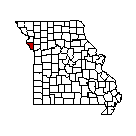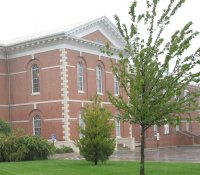Platte County MOGenWeb



Organized: December 31, 1838
Named after: Platte River
County seat: Platte City
organized December 31, 1838 from the Platte Purchase,
"Unfriendly Indians also delayed settlement in northwestern Missouri, ut the 1837 Platte Purchase secured the area by extending Missourie's northwest boudry to the Missouri River."
Lewis and Clark explored this area during their expedition of 1803-1806. Modern day Platte County began as a $7,500 government land purchase from the Iowa, Sac and Fox Indians. The Platte Purchase, as the transaction was titled, encompassed six counties. Named after the Platte River, the most southern portion of the Platte Purchase was named Platte County.
named for the Platte River. (Platte is derived from the French word for a low, shallow, or intermittent stream.)
On November 7, 1872, the Platte County Court divided the county into 13 townships: Camden Point; Fair; Pettis; Lee; Magee; May; New Market; Parkville; Waldron; Ridgely; Salem; Miller and Weston
County Courthouse History:
Original: Built 1841- 1861 Arch- Demetrius A. Sutton, Destroyed.
Present: Built 1866, Arch- Peter McDuff, Contr- J. A. McGonigle
About the first courthouse:
After the court had been meeting in homes and rental property, Platte County paid $100 for a double log structure to use as a courthouse in February 1840. The court used this building for nearly two years until the first permanent courthouse was completed. Construction for the permanent courthouse had been ordered in May 1840. W. M. Paxton, in Annals of Platte County, claims that Demetrius A. Sutton (1795-1848), an experienced architect, drew the plans and prepared the specifications for the 50-foot-square brick courthouse. For this service the court paid him $10. He also served on the courthouse building committee.
Sutton, a native of Fayette County, Kentucky, gained the respect of his Platte County associates, who considered him intelligent, well read, agreeable and talented. In addition to providing the plan and design of the courthouse, he may have been responsible for the drawing found in the clerk's office.
The two-story building, completed by the November 1841 court term, faced south. On the first floor, a center hall led to the courtroom on the north. Two 18-foot-square offices on either side of the hall faced south. The second story repeated the arrangement.
The original courthouse was located one block west of where the current courthouse stands.About the present courthouse:
During a Civil War raid, Colonel Morgan's men on December 16, 1861, destroyed the courthouse and several dwellings and churches due to the strong southern sentiments in Platte City. Advance warning helped save all the valuable circuit court records.
"They started the fire at the dead hour of midnight,at a time when people would be glad and fortunate if they escaped with their lives, to say nothing of homes and property. First, the flames bursting above Mr.Cochran's store,which had probably already been robbed, aroused the town. This was in block 29, just now the present drug store of Tully Ellifrit. The wind was from the southeast.
Spreading rapidly,the fire soon enveloped all the row of buildings from Cochran's to the corner. Firebrands flew across to the court- house and set it on fire. Morgan now appeared on the streets and pretended that he did not want to burn the court-house, but only the other buildings. Knowing that he could not save it, he made great demonstrations toward doing so, but really he did nothing. It too went down in ashes ; and when the sun rose the next morning his kindly beneficent rays fell upon the ruin that an adventurer and scoundrel in shoulder straps had wrought.
One of the best portions of the business part of Platte City had been destroyed ; and the court-house,the public building of the county, that hard working, honest men and tax-payers, Union men as well as so-called "rebels," men of all parties, had paid for,was burnt. This served greatly to enthuse the people for the Union cause!" 1

In September 1864 the court appropriated $40,000 to begin construction of a new courthouse. Cornerstone ceremonies took place on June 20, 1866. Construction was completed by May 1867.
The architect chosen was, Peter McDuff,
The building faces south and features a triple-arched entry in the center pavilion. The black and white square flagstones on the foyer floor have been a particular source of pride. Several additions have been made through the years to this building that continues to serve as Platte County's courthouse.
Sources:
- History of Clay and Platte Counties, Missouri. St. Louis: National Historical Company, 1885., pg 699.
- Paxton, W. M. Annals of Platte County, Missouri. Kansas City: Hudson-Kimberly Publishing, 1897, Pg 41. Reprinted Cape Girardeau: Ramfre Press, 1960.
Populated Places:
- Camden Point
- Dearborn
- Edgerton
- Farley
- Ferrelview
- Houston Lake
- Iatan
- Lake Waukomis
- Northmoor
- Parkeville
- Platte City
- Platte Woods
- Ridgely
- Riverside
- Tracy
- Weatherby Lake
- Weston


